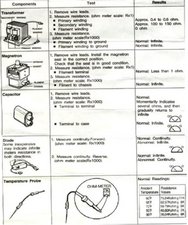It seems like your diode is bad. You say your cheaper DMM reads the diode as open in both directions, and then say it passes voltage in both directions. These are two opposite scenarios, but either is a bad diode. You should have continuity (i.e. closed) in only one direction. If you have continuity in both directions the diode is shorted, and is defective. If the diode does not have continuity in either direction it is open, and is defective.
Plus, your battery test should only pass voltage in one direction - the other direction should be 0.0 VDC. Replace the diode and see if this solves your problem.
Here is a site that explains the process. https://www.partselect.com/Microwave+tes...
Update 5/14/18:
Given that the 9v test measured voltage in one direction but not the other, indicates your diode is good. The voltage drop of the diode is most likely too great for your DMM to take a measurement. You component test chart even states, "Some inexpensive [meters] may indicate infinite resistance in both directions." So accept the 9v test.
So now I'm assuming your question is that even though the troubleshooting flow chart is recommending you replace the magnetron, your individual test of the component checks out good, so which is it. Most likely you have a short in the magentron (causing the humming). Try this: when measuring filament to chassis, tap on the magnetron to see if you can get it to show an intermittent short. The other explanation is the short happens only when the filament heats up during operation, but you don't want to test a live magentron.
You have already performed all the tests you can on the diode, HVC and HVT. They could still be bad (like a short between the windings of the secondary), but you do not have a accurate way of measuring them. The other check you can do is the wiring in the high voltage circuit. Check for burnt terminals, discolored wires, etc. Otherwise, I would replace the magnetron first, and see if this solves the problem. If not, next replace the HVC and diode. If this still doesn't solve the problem, replace the HVT.




 3
3  2
2  3
3 